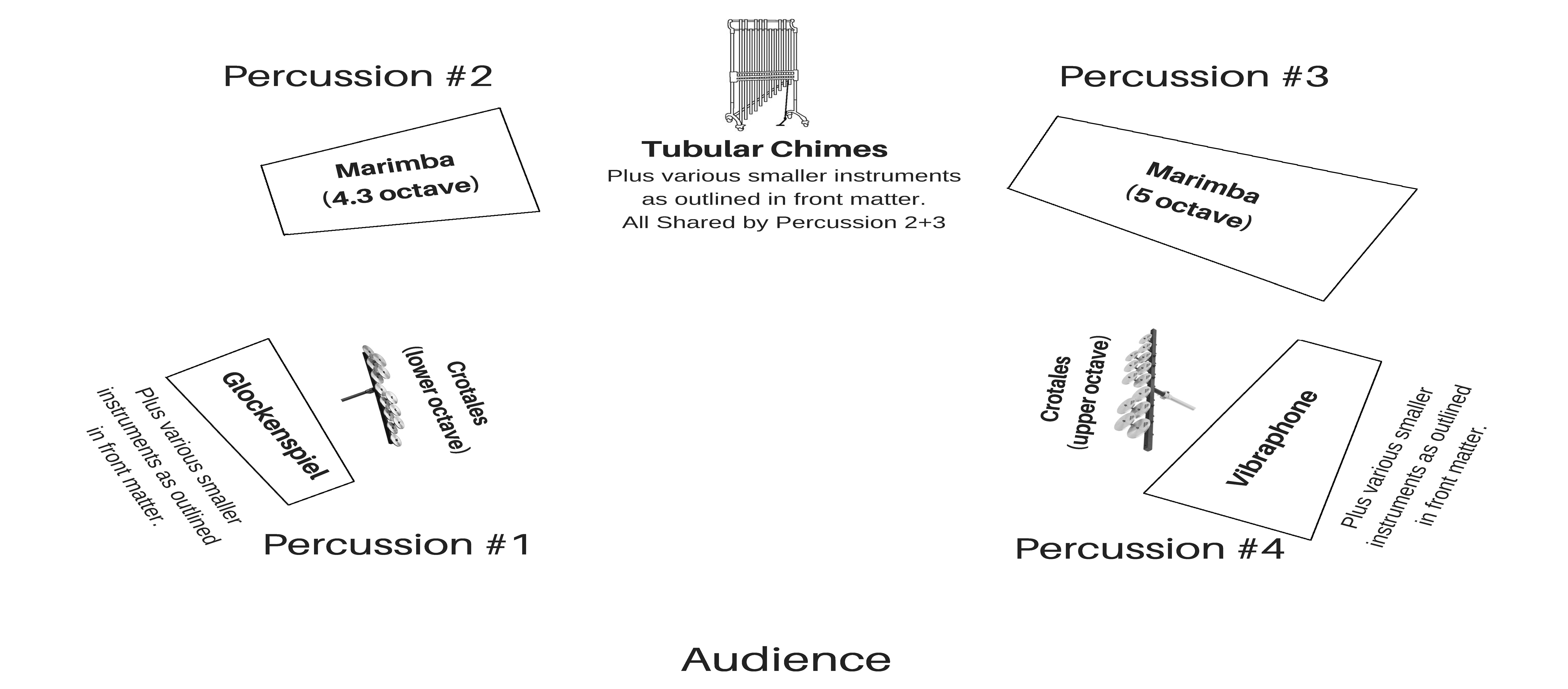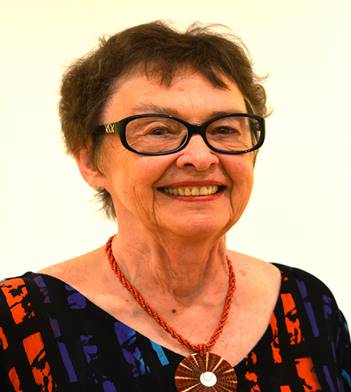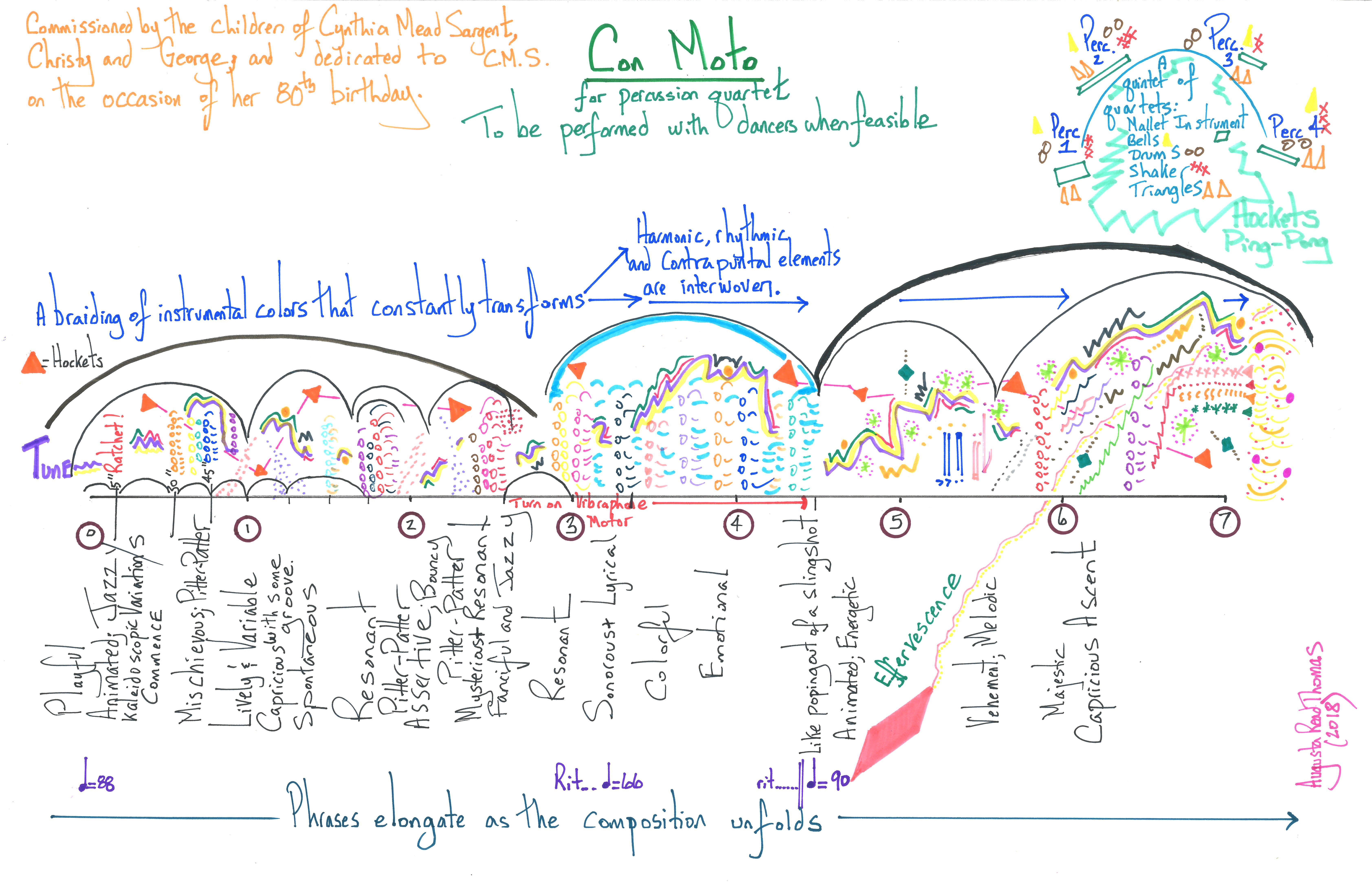Commissioned by the Children of Cynthia Mead Sargent and dedicated with admiration and gratitude Cynthia Mead Sargent on the occasion of her 80th Birthday.
First performance given by Third Coast Percussion on 16 October 2020 when Augusta was Featured Composer at the 41st Annual New Music Festival, Bowling Green University.
Duration: 6 Minutes
World premiere recording organized by Beyond This Point and performed by John Corkill, Adam Rosenblatt, Garrett Arney, and Nonoka Mizukami recorded on 25 September 2023 at the Logan Center of the University of Chicago.
CON MOTO could be played by 8 players.
(2 players dividing the 4 parts - one player on the mallet instrument(s) and the team-mate player on the other instruments for each of the 4 parts.) Doing it with 8 players ensures that each part is not too technically difficult, etc. If you had an extra player that you did not want to leave out of the project, then that player could, for example, play the Chimes part, etc.
This composition can be paired with STAR BOX. The instrumentations and layout of the two scores are very similar but not identical.
Following a long and rich tradition of composers who wrote for percussion (Edgard Varèse, Harry Partch and John Cage, Lou Harrison) over the past 30 years, Augusta has composed extensively for percussion designing works including concerto for percussion quartet and orchestra, percussion playing bells from all around the world, quartets, solos, and two octets for percussion and string quartet. Additionally, many of her 65 orchestral works feature percussion.
Five quartets of colorful instrumentation ping-pong and hocket quickly between the four musicians who each play:
1: MALLETS (Vibraphone, Marimba, etc.)
2: BELLS (Glockenspiel, Crotales, etc.)
3: DRUMS (Bongos, Congas, Log, etc.)
4: SHAKER NOICE MAKER (Cabasa, Egg shaker, Maracas, etc.)
5: TRIANGLES (of all sizes)
with a virtuosic display of rhythmic agility, counterpoint, and sensitive chamber music teamwork.
Con Moto performed by John Corkill, Adam Rosenblatt, Garrett Arney, and Nonoka Mizukami
Third Coast Percussion performs world premiere of Con Moto at the Bowling Green State University New Music Festival, 2020
Cynthia Mead Sargent is radiant, elegant, brilliant, expressive, graceful, fun, beautiful, generous, sophisticated, and positive. I am humbled by this opportunity to compose a work in her honor. The title CON MOTO hopefully captures the spirit of Cindy’s magnificence, twinkle, positive spirit, motion and energy.
I care about craft, clarity, and passion. My works are organic and, at every level, concerned with transformations and connections. The carefully sculpted musical materials of CON MOTO are agile and energized, and their flexibility allows a way to braid harmonic, rhythmic, and contrapuntal elements that are constantly transformed — at times whimsical and light, at times jazzy, at times layered and reverberating. Across CON MOTO’S six-minute duration, it unfolds a labyrinth of musical interrelationships and connections that showcase the musicians in a virtuosic display of rhythmic agility, counterpoint, skill, energy, dynamic range, clarity, and majesty. Throughout the kaleidoscopic journey, the work passes through various lively and colorful episodes, which propel the musical discourse always with a sense of dance, caprice, and effervescence.
Music’s eternal quality is its capacity for change, transformation and renewal. No one composer, musical style, school of thought, technical practice, or historical period can claim a monopoly on music’s truths. Commissioning new art is leap-of-faith! The commissioner does not know what they will receive. I feel profoundly fortunate for the investments made by Cindy’s children, and I devoted my strongest, most focused efforts to composing CON MOTO in honor of Cynthia Mead Sargent.
PERCUSSION 1:
Glockenspiel - Every note is “L.V. Molto” for the entire composition unless otherwise notated. (4 mallets needed)
Crotales (lower octave) every note is “L.V. Molto” for the entire composition.
2 Conga Drums (Lower in pitch than the Bongos that you are playing)
2 Bongo Drums [Higher in pitch (i.e.: tight skins) than the Congas.]
Ride Cymbal
Chinese Splash Cymbal
Triangle (very large) every attack is “L.V. Molto” for the entire composition unless otherwise notated.
2 Cowbells (Medium and High)
2 Woodblocks (small and large)- Please use very resonant instruments.
Ratchet (mounted)
Cabasa (mounted)
Tambourine (mounted but also able to be picked up)
Egg Shaker (mounted but also able to be picked up)
PERCUSSION 2:
Marimba (4.3 octave) Generally speaking do not play with hard mallets. Soft to medium mallets are always preferred. (4 mallets needed)
Everything below is shared with Percussion 3:
Tubular Chimes (Please use the most “in-tune” set of chimes possible.)
Tenor Drum
Log Drum
Very large tam-tam
Large Suspended Cymbal
2 Woodblocks (Low and medium)
Guiro (mounted)
Ratchet (mounted)
Maracas (mounted)
2 Triangles (small and medium)- Every attack is “L.V. Molto” for the entire composition unless otherwise notated
Tambourine (mounted but also able to be picked up)
PERCUSSION 3:
Marimba (5 octave) Generally speaking do not play with hard mallets. Soft to medium mallets are always preferred. 4 mallets needed)
Everything below is shared with Percussion 2:
Tubular Chimes (Please use the most “in-tune” set of chimes possible.)
Tenor Drum
Log Drum
Very large tam-tam
Large Suspended Cymbal
2 Woodblocks (Low and medium)
Guiro (mounted)
Maracas (mounted)
2 Triangles (medium and small)- Every attack is “L.V. Molto” for the entire composition unless otherwise notated
Tambourine (mounted but also able to be picked up)
PERCUSSION 4:
Vibraphone (motor is used and motor speeds are indicated in the score and part) (4 mallets needed)
Crotales (upper octave C# and G) every note is “L.V. Molto” for the entire composition.
Tom-tom (low) (Please use drum on the lower end of the pitch spectrum)
5 Temple blocks
Egg Shaker (mounted but also able to be picked up)
2 Triangles (medium-large and very small)- Every attack is “L.V. Molto” for the entire composition unless otherwise notated
Tambourine (mounted but also able to be picked up)

Percussion #1 and #4 divide a complete, 2-octave set of Crotales
Percussion #2 and #3 share many instruments, which should be places between the two marimbas.
For Percussion #2 and 3, the Tam-tam and Guiro should be near the chimes.
The score calls for four triangles in the percussion parts. Care should be given to insure that each of the triangles has a slightly different “pitch and color” from one another, so that each of them has a unique contribution to the overall sonic palette and so they blend elegantly with the crotales, glockenspiel, and bell-like sounds. Likewise, the four wood blocks should each have a slightly different “pitch and color” from one another and from the 5 Temple Blocks. Likewise, the 4 bongos and 2 congas should each have a slightly different “pitch and color” from one another.
Unless otherwise specified above or on the score, use most common beater or mallet
Tracy Monaghan, I CARE IF YOU LISTEN “Con Moto asks each player to be an extension of one another, as if the four musicians and myriad instruments are one. This requires a high level of expertise and precision, which the members of Third Coast Percussion easily delivered. The piece begins with an energetic melody layered with percussive interjections by the unpitched instruments. As the piece goes on, elements of jazz show themselves. At several moments in the complex piece, a jazz piano is evoked, but the broken chords are spread out across the four musicians. In the same breath, each player might have their own, self-contained rhythmic gestures and immediately shift to a collective rallentando.”


To obtain examination or performance material for this
Augusta Read Thomas work, please contact Nimbus Music Publishing.
